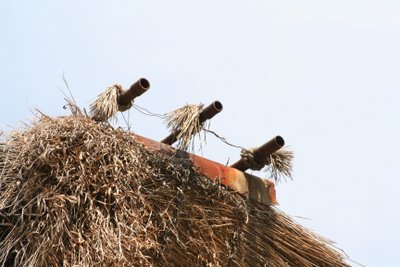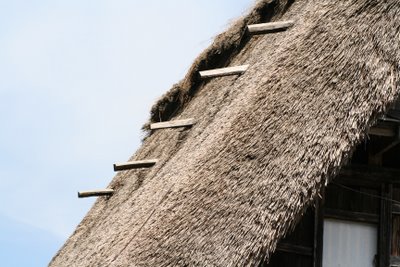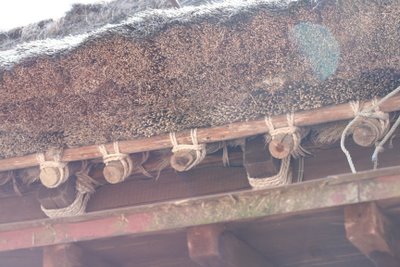
On the way out of the area, we came across a thatched roof house in town. It allowed visitors to come in to look. As we walked in, a little sparrow flew into the entry hall where we had to leave our shoes. She lit on this ledge and patiently watched us. She had a nest of babies on another ledge. Actually, I took this picture as we were leaving.
This hearth was in the middle of the main room downstairs. The kettle was hanging from a ceiling beam. Look through the rooms at the outside door leading to the garden. Only wood and glass separate the inside from the outside. Shutters are still used at night and during storms.
Despite all the windows and doors, the house was rather dark. I was surprised to see the darkly stained wood throughout the house. I had never seen that in Japanese houses.
This was the eave of the roof outside a window downstairs. Note the metal brace.
The only way up to the upper floors were ladders like this one.
This picture was taken from the top of the steps looking down to the first floor. It was a very steep climb. There wasn't much head room at the top because of the beams. Up to the third floor was a shorter climb.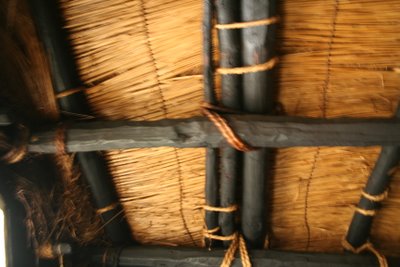
I'm glad I made it up to the third floor. This was the ceiling or the inside of the thatched roof.
Unfortunately these pictures turned out fuzzy. It is the inside view of the top of the roof. It was totally dark up there! The camera and I couldn't focus on anything. We didn't stay up there long.
The house was a small museum of items from long, long ago. On the first and second floors, there were bare light bulbs hanging from the ceiling, but it was so dark it was difficult to take pictures. (It was allowed.) I managed to get a picture of these coats that were hanging from the ceiling. They are made of straw. They were used in the snow and in the rain.
Can you guess what this is? It is a pillow. I have seen these in movies of times long, long ago. They prevented "bed hair". You have probably seen how women wear their hair with kimono. Women were able to sleep and keep their hairstyle intact by lying on their sides. This pillow was put at the base of their skull under their ear.
We stumbled around in the dark for a while before deciding to leave. I stumped my toe twice and had to hobble down those ladders. I made it to the entrance only to find that my shoes were gone! The last thing I wanted was to put shoes on my aching toes, but I had to walk to the car. It was dark down there in the entrance. I couldn't believe my eyes or hands. I looked on and fingered every shelf. Several times.
Papa ran out onto the street. He looked for the woman who took my shoes by mistake. Meanwhile, I had plenty of time to try to get an adequate picture of the bird and her nest. It was a shot in the dark, so I was lucky one picture turned out.
Fortunately, I had another pair of shoes in the car. The shoes that were taken were old and dusty. They weren't worth going back for or having them sent to me. We left with just a good story. We laughed and speculated about the woman who took them by mistake. Wonder when or if she noticed? Wonder if she went back for her shoes? Bless her heart! The shoes she left behind were cleaner and newer. Mine were mighty old and worn down. It's hard to imagine she didn't feel the difference. I have to say that my old shoes were pretty comfortable and I kinda miss them now!
If there had been a suggestion box, I would have suggested better lighting in the entry hall or flashlights for the shoe cabinet. But then again, "such kind of things" (a common phrase my students here used to use) never happen here!
August 24, 2006
World Heritage Site: Inside a Thatched Roof House
Posted by
Annie Donwerth Chikamatsu
at
6:17 PM
0
comments
![]()
Labels: August in Japan, pillows, shoes, tea, thatched-roof houses, World Heritage site
August 23, 2006
World Heritage Site: Leaving Ainokura


As we were leaving I noticed there was a stamp at the entrance. I wasn't with Papa when he went to pay. There was no one in the buidling as we were leaving.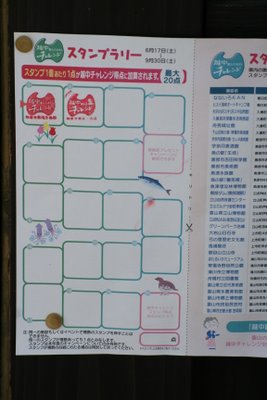
Another stamp opportunity. My children weren't interested in getting a stamp at each house. They would have loved this a few years ago. They enjoyed their time here, though.
I took this picture of the sign for the village with the thatched roof houses as we were leaving. The buildings here have typical tile roofs.
It is difficult to take pictures from the car! I saw several bus stops that I wanted to photograph, but it was impossible to stop (narrow roads) and impossible to do from the car (bad angles at speed). The bus stops were small buildings where people could stand out of the road and out of the weather. I imagine they are much appreciated in the snow and the rain!
This is Main street in the town outside the village.
Posted by
Annie Donwerth Chikamatsu
at
2:03 PM
0
comments
![]()
Labels: August in Japan, stamps, World Heritage site
World Heritage Site: Around Ainokura
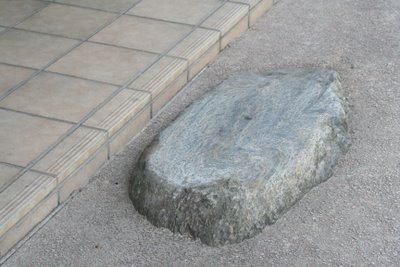
The porch tile on the front of this house had been replaced, but the old step had been kept.
This mill was on a porch near the front door.
This is a pump for one of the houses. It made a low purring sound.
A manhole in the village.
Posted by
Annie Donwerth Chikamatsu
at
1:12 PM
0
comments
![]()
Labels: August in Japan, manhole covers, thatched-roof houses, World Heritage site
World Heritage Site: Gardens and Paddies in Ainokura

It looked like a gardener wrapped her corn in the funny papers. It was actually pages from a junk mail flyer. Yet another way of recycling.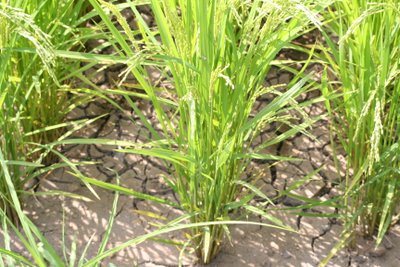
The rice here was mighty dry. It was surprising because it has been a very wet year and farmers in Niigata are worried about their rice crop not having enough sun this year.
More pictures of rice and other crops.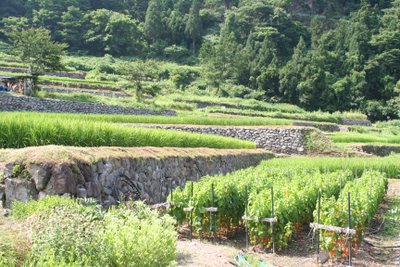
This field of Chinese lanterns was near the entrance of the parking lot. Can you see the orange "lanterns" hanging on the plants?
These are some Chinese lanterns that we bought this summer and put on our windowsill. They sell stems of them at flower shops.
Posted by
Annie Donwerth Chikamatsu
at
12:20 PM
0
comments
![]()
Labels: August in Japan, plants, rice, thatched-roof houses, World Heritage site
August 22, 2006
World Heritage Site: Gift Shop and Restaurant in Ainokura

We shopped at this shop. There were trinkets on straps or chains that can be hung on phones or bags or used as key chains.
A paper decoration.
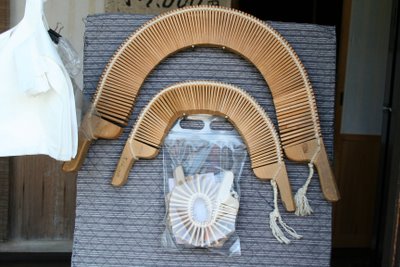
There were also souvenirs of traditional items like these straw snow boots and this wooden instrument used for a regional dance.
These eel traps could be used as decorations.
The shop also had tables in the front where customers could sit and order soba and rice balls to eat. The baskets along the side are part of the shop and are for sale.
I've included this close-up of the table because of the beautiful piece of wood. A container of chopsticks, a menu, an ashtray, and a bottle of soy sauce sit on top.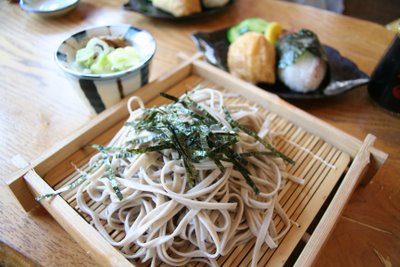
This is part of what we ordered. These noodles are called soba. We ordered them cold. It can also be ordered hot. It is dipped into a small cup of sauce made of soy sauce, mirin, and seaweed broth. There is a small plate of shallots and mushrooms on top of this cup that is scraped into the dipping cup. There are rice balls and pickled vegetables on the black plate shaped like a leaf. The bamboo "plates" are sold in the shop. You may be able to see them under the eel traps in the picture above.
Posted by
Annie Donwerth Chikamatsu
at
5:10 PM
0
comments
![]()
Labels: August in Japan, noodles, souvenirs, World Heritage site
World Heritage Site: Other Village Business in Ainokura

I have been wanting to take a picture of the postman in Tokyo. I keep missing him. It seems I always catch a glimpse of one as he is passing by. As we were having lunch, the postman of this village zoomed by. I ran out of the shop, but he made no other stops down the street. Wouldn't that have been a cool picture? A postman delivering mail to a thatched roof house. I went back in to finish my lunch. A little later, he zoomed past going the other way. We all looked at each other and laughed.
This is one of the hotels. Below is a closer look at the beds (futon) hanging out the door. They are airing them out. Laundry from the hotel is on the line outside, too.

Here is a house that has a small soft cream stand outside on its porch. See that big plastic soft cream on the porch? We sat on the benches there and had ice cream after lunch. Beds and laundry were hanging outside here, too.
Posted by
Annie Donwerth Chikamatsu
at
3:22 PM
0
comments
![]()
Labels: August in Japan, ice cream, postal, thatched-roof houses, World Heritage site
World Heritage Site: On the Hills of Ainokura

This temple was on a hill in the village. There was a huge electric pole behind it.
This was the temple's old basin that was used for washing hands. It had no water in it.
Up another hill behind all the old thatched roof houses, there was a modern community center.
Posted by
Annie Donwerth Chikamatsu
at
2:56 PM
0
comments
![]()
Labels: August in Japan, temple, World Heritage site
August 21, 2006
World Heritage Site: Thatched Roof Village in Toyama Prefecture

After visiting and staying with friends in a small town in Niigata Prefecture, staying overnight in a Japanese inn, and making paper at the Japanese Paper Experience House, we visited Ainokura Gasshouzukuri Shuuraku in Toyama Prefecture. This village of thatched roof houses was named a World Heritage Site by UNESCO in 1995. People still live in these houses. Some have small shops on the first floor. Two of them are inns.

For more information:
Gassho-style Farmhouses
Ministry of Foreign Affairs of Japan
Japan Guide
Shirakawa Village
Posted by
Annie Donwerth Chikamatsu
at
8:15 AM
1 comments
![]()
Labels: August in Japan, thatched-roof houses, World Heritage site
World Heritage Site: Oldest House in the Village of Ainokura Gasshouzukuri Shuuraku

The oldest house in the village is over 300 years old. The village, however, was established longer ago.
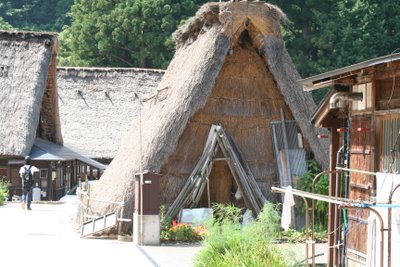
This is the back of the oldest house. No one lives in this house.
Posted by
Annie Donwerth Chikamatsu
at
8:14 AM
1 comments
![]()
Labels: August in Japan, thatched-roof houses, World Heritage site
World Heritage Site: Close-Ups of Thatched Roofs in Ainokura Gasshouzukuri Shuuraku
Posted by
Annie Donwerth Chikamatsu
at
7:38 AM
0
comments
![]()
Labels: August in Japan, thatched-roof houses, World Heritage site

